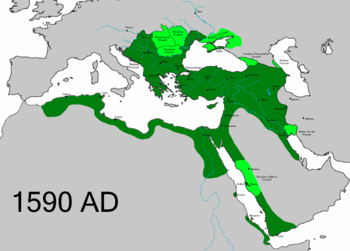Treaty of Constantinople (1590)

The Treaty of Constantinople, also known as Treaty of Ferhad Pasha[1] (Turkish: Ferhat Paşa Antlaşması), was a treaty between Ottoman Empire and Safavid Persia ending the Ottoman–Safavid War (1578–1590) and was signed on 21 May 1590 in Constantinople (Istanbul).
War
The war began in the Southern Caucasus. At the Battle of Çıldır, the Ottoman army defeated the Persian army and invaded most of the South Caucasus. After the Ottoman army returned to its main base in Constantinople, however, Persians began to regain some of their former territories. During the next phase, another Ottoman army (mostly composed of Crimean Tatars) arrived and Ottomans were able to attack once more. In 1583 after the battle named Battle of Torches (Ottoman Turkish: مشللر محاربسی), so called because the battle continued during night, Ottomans were able to reconquer the southern Caucasus from the Persians. During the next 6 years, the only significant event was the conquest of Tabriz by the Ottomans. Confronted by other problems (i.e. civil wars and the war against Uzbeks), Abbas I, the shah of Persia, agreed to sign a treaty with unfavorable terms.[2]
Treaty
The treaty is known as the Treaty of Constantinople or the treaty of Ferhad Pasha (Ferhad Pasha was the commander (Turkish: serdar) of the Ottoman Army). According to the treaty, the Ottoman Empire kept its gains in the war. These included most of the southern Caucasus, as well as Tabriz and northwest Iran.[3] Persians also agreed to pay obeisance to religious leaders of the Sunni faith.
Aftermath
This treaty was a success for the Ottoman Empire, as vast areas had been annexed. However, it was not long lasting. Abbas I, after solving problems at home, waited for a suitable moment to regain his former possessions. When the Ottoman Empire was engaged in Jelali revolts, he was able to regain most of his loses, which the Ottoman Empire had to accept in the Treaty of Nasuh Pasha, 22 years after this treaty.
See also
References
- ↑ Alexander Mikaberidze, Conflict and Conquest in the Islamic World: A Historical Encyclopedia, ABC-CLIO, 2011, p. 698.
- ↑ Prof. Yaşar Yücel-Prof. Ali Sevim:Türkiye Tarihi III, AKDTYKTTK Yayınları, 1991, pp. 21-23, 43-44
- ↑ Nicolae Iorga: Geschichte des Osmanischen Reichs Vol. III, (trans: Nilüfer Epçeli) Yeditepe Yayınları, 2009, ISBN 975-6480-20-3 ,p. 213